Banyo, evimizde en çok ziyaret edilen yerlerden biridir. Bu yüzden düzenlenmesi çok önemli bir şeydir. Her şeyden önce, bir klozet seçmeye değer. Standart boyutlara odaklanmak daha kolaydır. Hemen hemen her zevke uygun modeller bulabilirsiniz.
Makalenin içeriği
Tipler ve tasarım özellikleri
Klozetlerin boyutları tasarıma bağlıdır. Bu yüzden kendinizi onlara alıştırmanız gerekir. Aynı zamanda, küçük banyolara hangi tiplerin monte edilebileceğini öğrenelim.
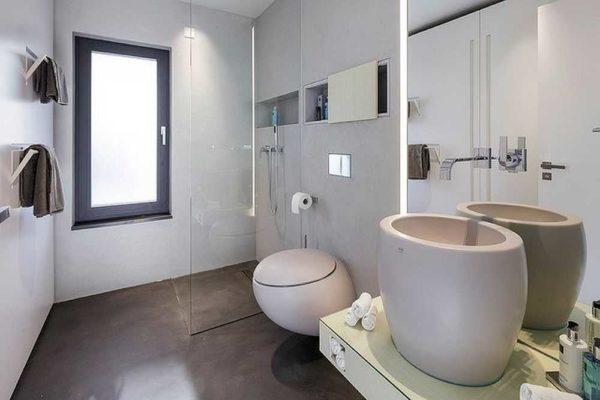
Kase şekli
Gider üzerindeki klozet tipleri veya klozetin şekli, kullanım kolaylığını ve olabilecek "lezzet" seviyesini belirler. Ayrıca, şekil minimum ve maksimum boyutları belirler. Üç tip klozet veya sifon vardır:
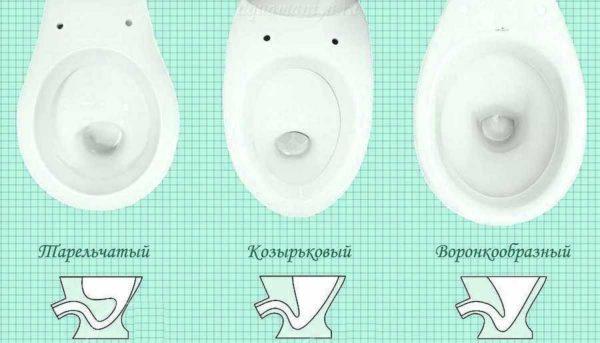
- Tabak veya raf tipi. Gider ön duvara daha yakındır ve haznede birinin raf, diğerinin ise plaka olarak adlandırdığı bir çıkıntı vardır. Şekillerin isimleri de buradan gelmektedir. Bu cihazla, sıçramalar sifonda olacaktır, bu hoş değildir, ancak en azından onları hissetmeyeceksiniz. Bununla birlikte, raflı klozet en "kokulu" olanıdır. Dışkı sifon çekilene kadar "rafta" kalır, bu nedenle koku yoğundur.
- Deveboynu. Gider de ön duvara daha yakındır, ancak haznenin arka duvarı düzdür ve drenaj hunisine doğru hafif bir eğim vardır. Bu tasarımla, atık arka duvara çıkar ve aşağıya suya doğru kayar. Sıçrama olmaz, koku mevcuttur, ancak çok yoğun değildir. Ana kaynak suda olmasına rağmen izler kalır.
- Huni şeklindedir. Böyle bir klozetin çanağının şekli sıradan bir huniye benzer. Gider neredeyse ortadadır. Neredeyse hiç koku olmayacak, ancak sıçramayı hissedeceksiniz. Kelimenin tam anlamıyla. Sıçramalarla, boyutların izin verdiği ölçüde (sizinki ve klozet) ileri/geri hareket ederek ya da önceden suya bir parça tuvalet kağıdı atarak mücadele edebilirsiniz.
Hangi klozeti seçmek daha iyidir? Genel olarak, kötü vizör değil. Sıçrama olmadan, tolere edilebilir bir "aroma" seviyesi ile. Doğru, her kullanımdan sonra bir ruff kullanmanız gerekecek. Ancak bu prosedüre çabucak alışırsınız.
Kurulum yöntemi
Kurulum yöntemine göre, iki tür tuvalet vardır: zemin ve asma. Zemin olanlarda her şey açıktır, zemine monte edilirler ve ona sabitlenirler. Bunlar iki tiptir. Birincisi - uzak bir rafta bir sarnıç veya duvarda bir sarnıç ile bizim için olağan. İkinci tip duvara monte edilir. Bu seçenek yakın zamanda ortaya çıktı. Arka duvarın duvara neredeyse tamamen paralel olmasıyla farklılık gösterir.
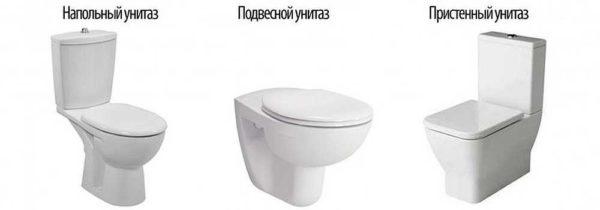
Asma veya gömme klozet, göründüğü gibi duvara değil, sahte bir duvarın arkasına gizlenmiş olan tasarıma tutturulur. Bu yapı "kurulum" olarak adlandırılır. Cıvatalarla duvarlara ve zemine sabitlenen metal bir çerçevedir. Ve zaten bu çerçeveye sadece kase değil, aynı zamanda düğme ve tüm borular da takılıdır.
Serbest Bırak
Tüm tasarım özellikleri bu değildir. Yine de çıkışla ilgilenmek gerekir. Bu, klozetin kanalizasyon sistemine bağlandığı çıkıştır. Dikey tıkaç çıkışlı en kompakt modeller. Eğik olan en uzun model. Ancak daha yaygındırlar, çünkü kanalizasyon borusunu yükseltmek gerekli değildir ve sadece bir tişört koyabilirsiniz ve içinde oluk açar.
Klozet çıkışlarının biçimleri de üç tanedir: düz, eğik ve dikey. Dikey olan artık çok nadirdir, ancak istenirse bulunabilir. Bu standart Amerika'da kullanılmaktadır. Ancak sipariş altında her şey mümkündür. Bu arada, dikey çıkışlı klozet en küçük "derinliğe" sahip olacaktır. Ve böyle bir çıkışla genellikle duvara monte modeller yapılır.

Çıkışa göre klozet nasıl seçilir? Sadece klozeti değiştirirseniz ve kanalizasyon sistemini yeniden düzenlemeyi planlamıyorsanız, başka seçenek yoktur, aslında başka seçenek yoktur. Orada bulunan aynı çıkışa sahip bir taneye ihtiyacınız var. Seçenek yok. Dairede kanalizasyon boruları değiştirirken düz eğik değiştirmek mümkün olacak, ya da tam tersi - eğik düz. Ancak dikey koymak işe yaramayacaktır - tahliye dikey olarak aşağıya, yani aşağıdaki komşularınıza gitmelidir. Bu, bir değiştirme yapmak zorunda kalacağınız anlamına gelir. Ne zaman dikey bir drenaj seçmelisiniz? Özel bir evde - birinci katta daha iyi. Alt zeminde veya bodrumda, boru kimseye müdahale etmeyecektir. Ve bu tip artı zaten dile getirildi - minimum "derinlik".
Klozet için rezervuar çeşitleri
Klozetin standart boyutlarıyla ilgilenmeden önce, rezervuar tipini düşünmeniz gerekir. Bu aynı zamanda boyutu da etkiler. Örneğin, popüler kompakt model, en "kısa" olmaktan uzaktır. Burada üstünlük avuç içi, ayrı bir duvara monte sarnıçlı modellerdedir. Ancak yine de sarnıcın ve klozetin bağlı olduğu boruyu hesaba katmanız gerekir.
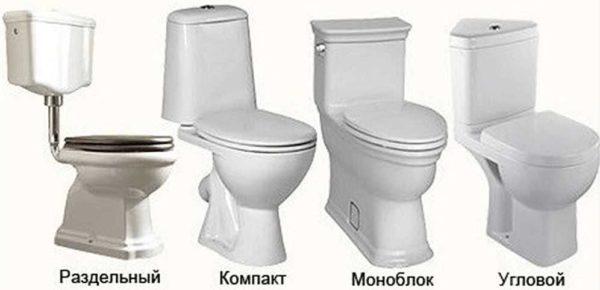
Genel olarak üç tip tuvalet rezervuarı vardır: ayrı (duvara monte), kompakt ve monoblok. Kompakt ve monoblok düz veya köşeli olabilir. Köşe modelleri, kural olarak, en küçük olanlardır. Ve kesinlikle küçük bir tuvalette yerden tasarruf etmenizi sağlarlar.
Sarnıçlar arasındaki farklar nelerdir? Temel bir fark yoktur. Bu, sahiplerinin tercihi, kuyu ve görünüm meselesidir. Monoblok, hazne ve sarnıcın tek bir biçimde kalıplandığı ve ayrılamadığı durumdur. Kompakt - bu, tankın kasenin arkasına monte edildiği zamandır. Bu tür modellerde, çanağın arkasında sarnıcı sabitlemek için delikleri olan özel bir çıkış vardır. Bu seçenek hakkında iyi olan nedir? Sarnıçları değiştirebilirsiniz. Sadece eskisi çatladığında değil, aynı zamanda şeklini veya hacmini özlediğinizde de. Bu da olabilir. Duvara monte sarnıçların aynı avantajları. Tek fark, bunları sabitlemeniz ve bir bağlantı borusu takmanız gerekecek.
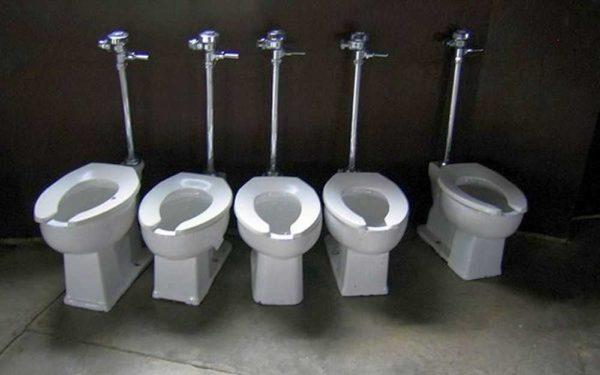
Bu arada, sarnıcı olmayan tuvaletler de vardır. Bunlar tesisatın içine gizlenmiş olanlar değil, doğrudan su kaynağına bağlı olanlardır. Bu model Almanya'da kullanılıyor ve bizde de bazı umumi tuvaletlerde var. Ana avantajı yerden tasarruf etmektir. Nasıl bakarsanız bakın, rezervuar yer kaplar. Eğer alan çok yetersizse, bunlardan birini koyabilirsiniz. Ancak sisteminizde çalışması için gereken basıncın yeterli olması şartıyla.
Mesafeler
Banyo veya tuvalet için geniş bir odaya sahip olanlar için iyi. Çok büyük değilse, klozetten yakındaki "yapılara" ve cihazlara olan mesafe için minimum toleransları bilmeniz gerekir.
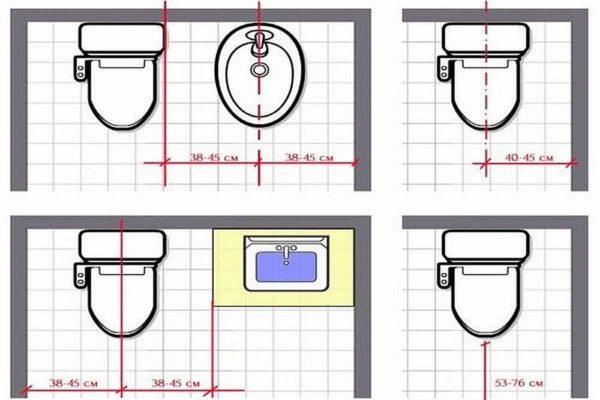
- Taharet musluğu ile klozet arasında en az 25 cm olmalıdır.
- Ön tarafta en az 60 cm boş alan olmalıdır. Yani, kasenin kenarından öndeki kapıya veya duvara olan mesafe 60 cm veya daha fazladır.
- Yanlarda en az 25 cm boş alan olmalıdır. Bu yeterli değildir, ancak tolere edilebilir. Rahat mesafe 35 cm'dir.
Şimdi banyonuzun bir planını çizin, minimum mesafeyi işaretleyin ve tuvaletinizde hangi boyutta klozetin duracağını görün. Yani her şey çok basit.
Standart klozet boyutları ve minimum tuvalet boyutu
GOST 30493-96 sadece raflı tuvaletlerin boyutunu normlar. Hala arabalara monte edilenler var, ancak onlara ihtiyacımız yok. Raflı bir klozetin standart boyutları iki varyant için öngörülmüştür: katı döküm ve takılabilir olan. İkinci model, menteşeli/duvara monte sarnıçlı veya bunlarsız bir sette kullanılır. Ayrıca standart boyutlarda çocuk tuvaleti de vardır. Bunlar (çocuklar) rafsız olarak gelir. Tüm boyutlar tabloda verilmiştir. Ve ne hakkında konuştuğumuzu anlamak için çizimlere bakıyoruz.

| WC tasarımı | H | h | h1 | l | l1 | L (derinlik veya uzunluk) | b | B (en geniş noktada genişlik) |
|---|---|---|---|---|---|---|---|---|
| Tek parçalı rezervuar rafı ile (Kompakt) | 150 | 330 | 435 | en az 605 (575 mm olabilir) | 260 | 340 и 360 | ||
| Rafsız (menteşeli rezervuar) | 370 и 400 | 320 и 350 | 460 | |||||
| Çocuklar için | 335 | 285 | 130 | 280 | 380 | 405 | 210 | 290 |
Yani, raflı klozetin standart boyutu (genellikle "Kompakt" olarak adlandırılır):
- Uzunluk - L - 605 mm. Bu, modelin bir sarnıcın montajı için bir çıkıntı ile kompakt olduğu dikkate alınır. Uzunluğu 575 mm'ye kadar daha kısa modeller üretmenin mümkün olduğu ayrıca belirtilmiştir.
- Genişlik - B - ayrıca iki standart değer: 340 ve 360 mm.
Klozetlerin yüksekliği normalize edilmemiştir, ancak genellikle 370-390 mm arasındadır. Yani standarda göre, en dar klozet - 340 mm ve en kısa model "raflı ve eğik drenajlı kompakt" - 575 mm. Bu değerlere ve bir önceki paragraftaki izin verilen minimum mesafelere dayanarak, böyle bir modelin kurulumu için tuvaletin minimum boyutlarını belirleyebiliriz. Genişliği hesaplayarak başlayalım: 340 mm + 2*250 mm = 840 mm. Yani, duvarlar arasındaki mesafe 84 cm'den az olamaz. Daha iyisi, elbette, daha fazlası.
Ve tuvaletin uzunluğu 575 mm + 600 mm = 1175 mm olmalıdır. Ancak bu, kanalizasyon borusunu döşemeniz ve bir şekilde gideri bağlamanız gerektiği gerçeğini hesaba katmaz. Bunun için 20 cm daha ayıracağız. Toplamda tuvalet odasının minimum uzunluğunun 1175 mm + 200 mm = 1375 mm olduğunu görüyoruz. Metre cinsinden 1,375 m'dir.
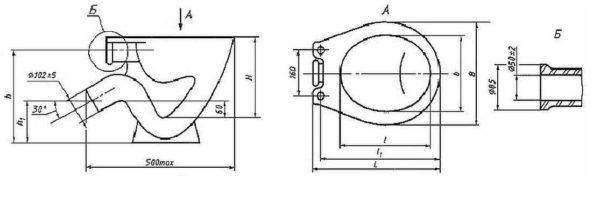
Duvara monte rezervuarlı klozetin standart boyutları önemli ölçüde daha küçüktür: uzunluk / derinlik 460 mm, genişlik 360 mm ve 340 mm. Yani, oda daha kısa olabilir. Minimum derinliği 1060 mm'dir - bu sadece kasenin rahat bir şekilde yerleştirilmesi içindir, ancak yine de boruları bağlamanız gerekir, bu nedenle 20 cm daha ekleyin. Toplamda, duvara monte rezervuarlı bir klozet kurmak için odanın en az 126 * 84 cm olması gerektiğini anlıyoruz. Daha uzun bir odanız varsa, sıhhi tesisat mucizesini geri taşıyabilir ve raflı bir dolap yapmak için tuvaletin arkasına ve / veya üstüne taşıyabilirsiniz.
Hangi boyutlarda klozetler var
Standart klozet boyutları, ortalama boy ve yapıdaki insanlar için tasarlanmıştır. Herkes böyle değildir. Evet ve GOST'ta tarif edilen raflı bir klozet, aromalar açısından en iyi seçim olmaktan uzaktır. Ayrıca, bugün mağazalarda ithal ürünlerin çoğu var. Ve onların da kendi standartları var. Örneğin, klozetin Avrupa standart boyutu 680*360*400 mm'dir (bu uzunluk, en geniş kısımdaki genişlik ve son rakam - yüksekliktir). Amerikalılar daha da ileri gittiler - her zamanki "derinlik" 768 mm, genişlik 380 mm, jantın zeminden yüksekliği aynı - 36-38 cm. Gördüğünüz gibi, standartlar farklı ve herkes standartlara göre üretim yapmıyor. İnsanların farklı talepleri var ve pazar bunları karşılamaya çalışıyor.
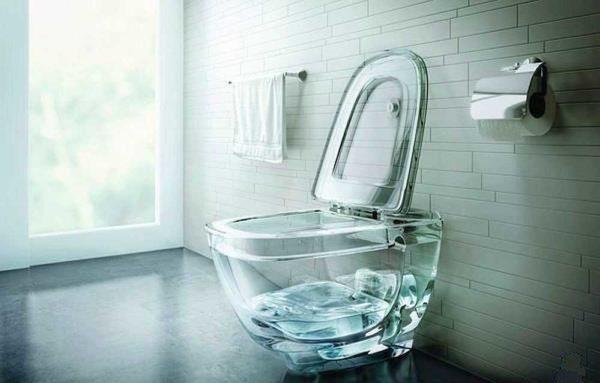
Zemin modellerinin boyutları
Anladığınız gibi, tuvaletlerin zemin modelleri farklıdır ve boyutları da farklıdır. İşte aralık, ancak daha dar veya daha geniş olanların olmadığını garanti etmiyoruz. Büyük olasılıkla, aklınıza koyarsanız, her ikisini de bulabilirsiniz.
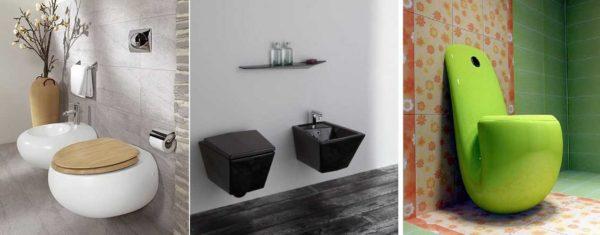
Kompakt
Kompakt tip klozet (arkaya takılı bir rezervuar ile) aşağıdaki boyutlara sahiptir:
- uzunluk - 610-645 mm;
- 345 mm'den 420 mm'ye kadar genişlik;
- yüksekliği 370 mm ila 395 mm arasındadır.
En dar kaselerin daha çok dikdörtgene benzediğine dikkat edin. Alıştığımız gibi yuvarlak değiller. Bunları kullanmak oldukça uygundur. Sadece kapak satın alırken sorun olabilir. Bu şekil pek sık bulunmaz.
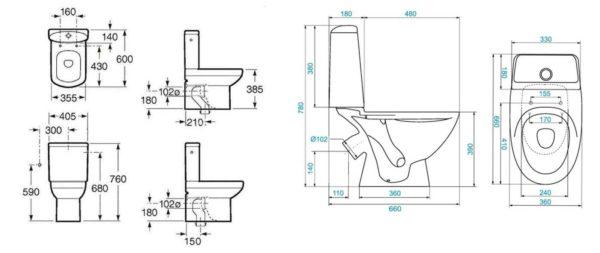
Sarnıç olmadan
Menteşeli veya ayrı rezervuarlı rafsız bir klozet aşağıdaki boyutlara sahiptir:
- uzunluk 435-460 mm (Kompakt modellerden 20 cm daha az!);
- genişlik 360-400 mm;
- zemin seviyesinden jant yüksekliği 350-390 mm.
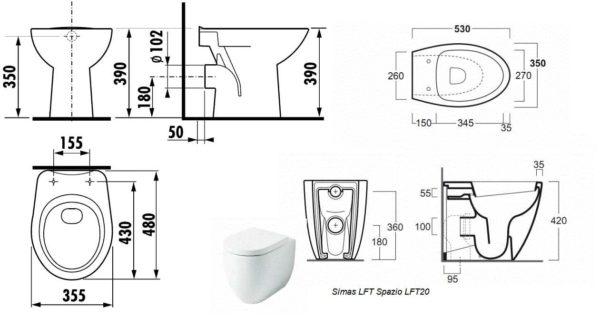
Gördüğünüz gibi, önceki varyanta verilen isme rağmen daha kompakttırlar. Ancak bu tür modeller daha az popülerdir, çünkü sarnıcın sabitlenmesi gerekir ve bu ek bir baş ağrısıdır. Ve daha önce bu tip bir "kalıntı" olarak kabul edildi, şimdi - şık ve ilginç. Çok ilginç modeller var (yine de ilginç maliyetleri var).
Monoblok
Monoblok yer tuvaletleri de vardır. Bunlar da çoğunlukla duvara monte edilir. Bunlar rezervuar ve haznenin ayrılabilir olmadığı ve birinin diğerinin uzantısı olduğu klozetlerdir. Monoblok klozetlerin ölçüleri aşağıdaki gibidir:
- uzunluk - 665-720 mm;
- genişlik (genellikle sarnıç daha geniştir, ancak her zaman değil) - 360-420 mm;
- yükseklik
- zeminden kapağın üstüne kadar - 700-870 mm;
- zeminden çanağın kenarına kadar - 360-390 mm.
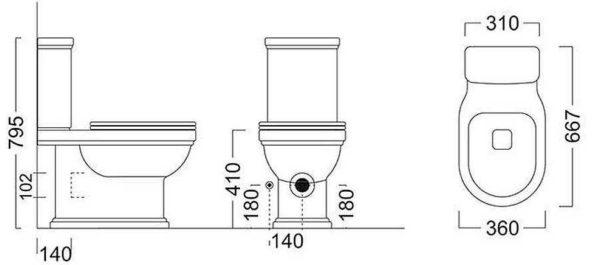
Bu modeller küçük değil. Belki de bu yüzden ülkemizde çok popüler değiller. Nasıl çevirirseniz çevirin, hazneyi ve sarnıcı ayrı ayrı getirmek tüm konstrüksiyondan daha kolaydır. Ancak sızıntı olasılığı daha azdır.
Asma modellerin boyutları
Asma klozetlerde, çanağın boyutuna ve kuruluma bakmanız gerekir. Genellikle bir set halinde gelirler. Ve kural olarak, kurulumla ilgili daha fazla soru ortaya çıkar. Aslında, kurulumun boyutu planlanan yüke bağlıdır. Dış güvenilmezlik ve kırılganlık aldatıcıdır. Güçlendirilmiş çerçeveli bir asma klozet, 400 kg'a kadar ağırlığa, standart tasarımlara - 200 kg'a kadar ve süper güçlü - 400 kg'a kadar dayanabilir.
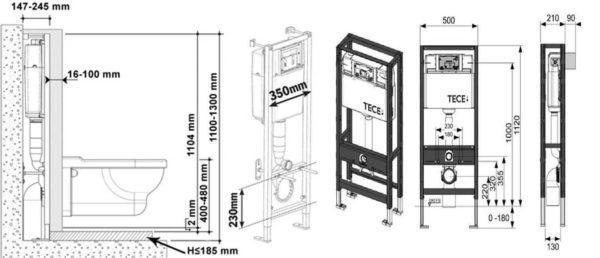
Asma klozetler için tesisat boyutları aşağıdaki gibidir:
- yükseklik - 1100-1250 mm;
- genişlik - 400-550 mm;
- derinlik - 140-250 mm.
Bunlar ortalama değerlerdir. Ayrıca dar kurulumlar da vardır - 345 mm'den olabilirler. Doğru, "taşıma kapasiteleri" yaklaşık 120-150 kg'dır. Ve bulunanlar, çoğunlukla yaklaşık 50 cm genişliğindedir. Gördüğünüz gibi, çok fazla yer kaplamıyorlar.
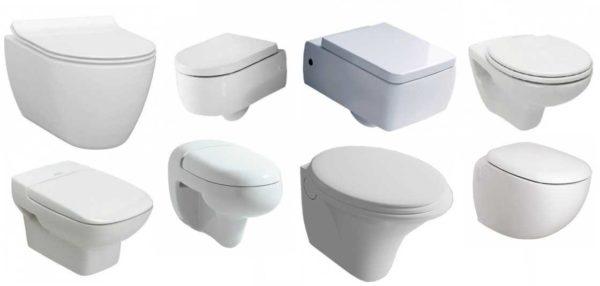
Şimdi de asma klozetlerin boyutlarına gelelim. Bu boyutlara sahiptir:
- uzunluk 480-560 mm;
- genişlik 356-430 mm.
Asma klozetin çanağının yüksekliği farklı olabilir. Bu stile bağlıdır. Neredeyse düz, 290-320 mm yüksekliğinde kaseler var, orta boy var - 340-365 mm. Ve çok farklı bir görünüme sahiptirler: kare, yuvarlak, oval, dibe doğru daralmış veya yuvarlak, daha çok bir disk gibi.
Asma ankastre klozetin zemine göre hangi yükseklikte yerleştirileceği konusunda hala soru işaretleri olabilir. Endişelenmeyin. Yükseklik otomatik olarak "seçilecektir". Klozetin boyutlarına ve tesisattaki kanalizasyon çıkışı için deliğin konumuna bağlı olacaktır. Sadece uyumlu olduklarından (aynı boyutta olduklarından ve çanağın alt kısmının zeminde "yatmadığından") emin olmanız gerekecektir.

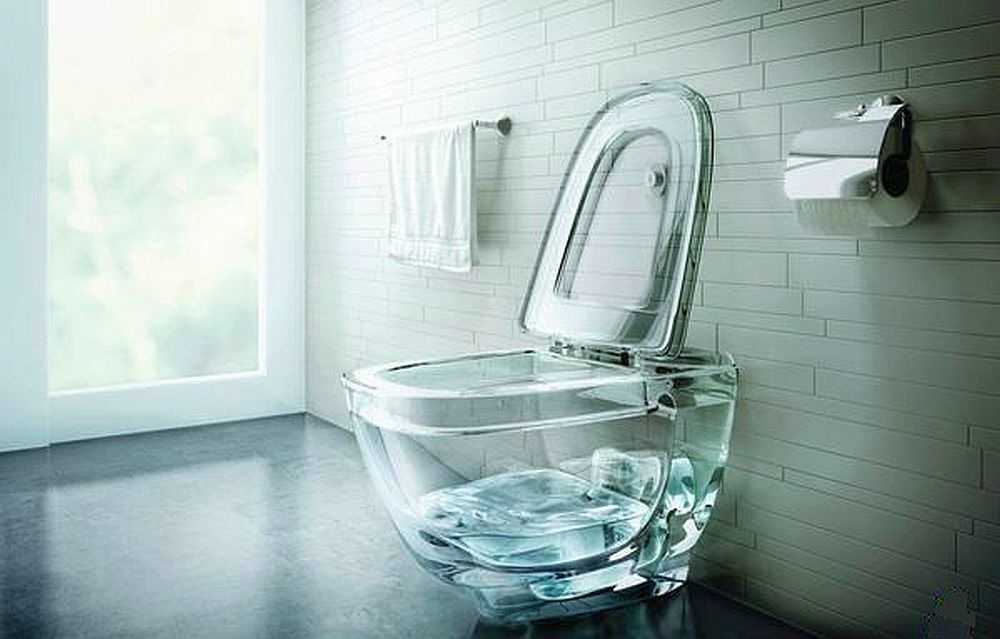
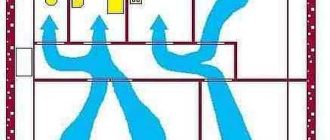
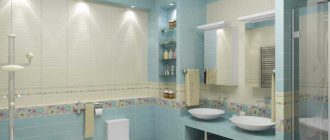
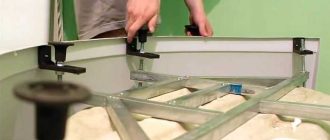
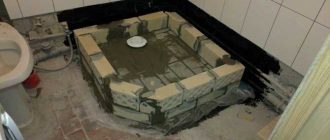
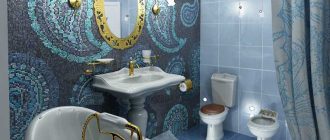
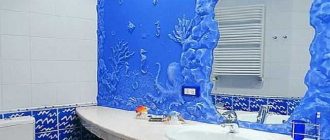
Bir ev sahibi olarak yakın zamanda banyomu yeniledim ve asma klozet için boyutlara karar vermem gerekti. Yer tasarrufu sağlayan tasarımların, küçük banyoları daha büyük hissettirirken aynı zamanda işlevsel olmalarına da yardımcı olduğunu gördüm. Doğru boyutun odanın tüm havasını nasıl değiştirebildiği inanılmaz!
Hey, I recently had to pick a new toilet for my tiny bathroom. The wall-hung one saved a lot of space! Make sure to measure everything first—dimensions really matter. I learned the hard way that the wrong size can mess up your whole layout. Happy renovating!